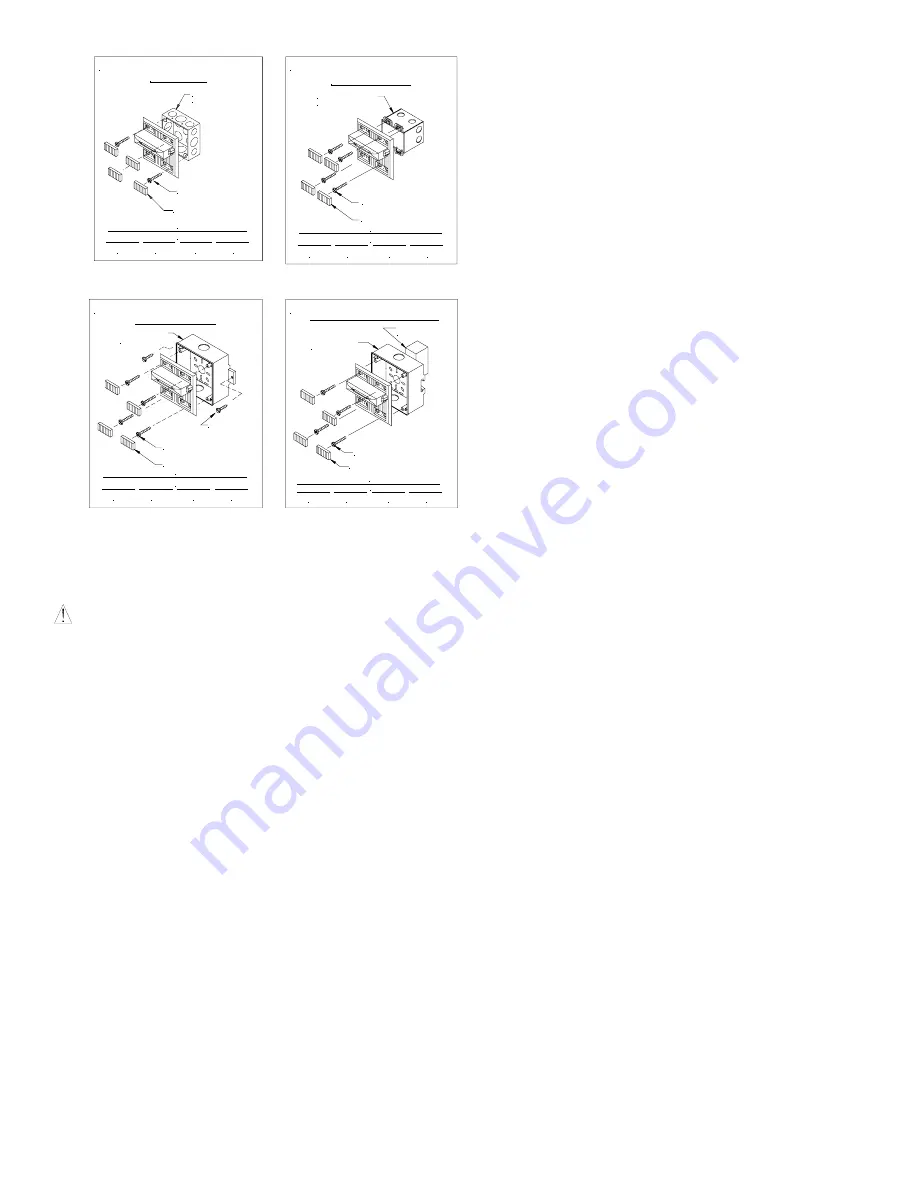
Siemens Building Technologies, Inc
. P84391-003B
Sheet 4 of 4
Figure A
FLUSH (4" BOX)
#8-32 SCREWS
4" SQ. X 2-1/8"
DEEP BACKBOX
SCREW COVERS
8
4
8
8
AWG #18 AWG #16 AWG #14 AWG #12
MAXIMUM NUMBER OF CONDUCTORS
Figure B
8
8
8
8
AWG #18 AWG #16 AWG #14 AWG #12
MAXIMUM NUMBER OF CONDUCTORS
#6-32 SCREWS
SCREW COVERS
FLUSH (2-GANG BOX)
2-GANG x 3-1/2"
DEEP BACKBOX
Figure C
8
8
8
8
AWG #18 AWG #16 AWG #14 AWG #12
MAXIMUM NUMBER OF CONDUCTORS
WOOD SCREWS
#8-18 SCREWS
SCREW COVERS
SURFACE MOUNTING
BACKBOX
(MT-SUR-BOX)
Figure D
8
8
8
8
AWG #18 AWG #16 AWG #14 AWG #12
MAXIMUM NUMBER OF CONDUCTORS
#8-18 SCREWS
SCREW COVERS
CONCEALED CONDUIT MOUNTING
BACKBOX
(MT-SUR-BOX)
EXISTING
BOX IN WALL
MOUNTING PROCEDURES:
1. This HS-MC model can be flush mounted to a 100mm
backbox (Figure A) or double-gang backbox (Figure B).
It can also be surface mounted to a indoor/outdoor
backbox (Figures C & D). Mounting hardware for each
mounting option is supplied.
2. Conduit entrances to the backbox should be selected to
provide sufficient wiring clearance for the installed
product. Do not pass additional wires (used for other
than the signaling appliance) through the backbox. Such
additional wires could result in insufficient wiring space
for the signaling appliance.
3. When terminating field wires, do not use more lead
length than required. Excess lead length could result in
insufficient wiring space for the appliance.
4. Use care and proper techniques to position the field wires
in the backbox so that they use minimum space and
produce minimum stress on the product. This is
especially important for stiff, heavy gauge wires and
wires with thick insulation or sheathing.
5. Connect field wires to the HS-MC terminal block (polarity
must be observed). Bend the field wires up 90
°
at the
connection to the terminal block.
6. Carefully push the field wires into the backbox by hand.
Press the HS-MC to the backbox, verifying that it is
seated and aligned correctly.
7. Fasten the HS-MC to the backbox using the supplied
screws.
The HS-MC 110cd setting is Listed for use in sleeping or non-sleeping areas when installed in accordance with appropriate NFPA Standards and the
AHJ.
WARNING: A SMALL POSSIBILITY EXISTS THAT THE USE OF MULTIPLE STROBES WITHIN A PERSON'S FIELD OF VIEW, UNDER
CERTAIN CIRCUMSTANCES, MIGHT INDUCE A PHOTO-SENSITIVE RESPONSE IN PERSONS WITH EPILEPSY. STROBE REFLECTIONS IN A
GLASS OR MIRRORED SURFACE MIGHT ALSO INDUCE SUCH A RESPONSE. TO MINIMIZE THIS POSSIBLE HAZARD, SIEMENS STRONGLY
RECOMMENDS THAT THE STROBES INSTALLED SHOULD NOT PRESENT A COMPOSITE FLASH RATE IN THE FIELD OF VIEW WHICH
EXCEEDS FIVE Hz AT THE OPERATING VOLTAGE OF THE STROBES. SIEMENS ALSO STRONGLY RECOMMENDS THAT THE INTENSITY AND
COMPOSITE FLASH RATE OF INSTALLED STROBES COMPLY WITH LEVELS ESTABLISHED BY APPLICABLE LAWS, STANDARDS,
REGULATIONS, CODES AND GUIDELINES.
NOTE:
This equipment has been tested and found to comply with the limits for a Class B digital appliance, pursuant to Part 15 of the FCC Rules. These
limits are designed to provide reasonable protection against harmful interference in residential installation. This equipment generates, uses and can
radiate radio frequency energy and, if not installed and used in accordance with the instructions, may cause harmful interference to radio
communications. However, there is no guarantee that interference will not occur in a particular installation. If this equipment does cause harmful
interference to radio or television reception, which can be determined by turning the equipment off and on, the user is encouraged to try to correct the
interference by one or more of the following measures: 1) Reorient or relocate the receiving antenna, 2) Increase the separation between the
equipment and receiver, 3) Connect the equipment into an outlet on a circuit different from that to which the receiver is connected, and 4) Consult the
dealer or an experienced radio/TV technician for help.









